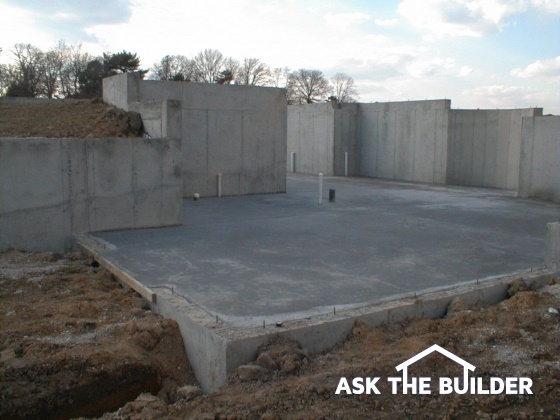Foundation Choices Are Many

DEAR TIM: I'll be very brief. My wife and I are building a new home soon and wonder which foundation is the best. Should we do a simple slab on grade, a crawl space or a full foundation with a basement? What are the pros and cons of each? Daniel V., Potsdam, NY
DEAR DANIEL: You are fortunate to have all three choices. Many people, because of local soil and groundwater conditions, often have only one or two options when it comes to house foundations. In certain places, constructing a full basement means blasting through solid rock. In other places, the ground water table may be lurking just a few feet below the surface limiting these folks to a simple slab on grade.
The slab on grade choice is very attractive to builders because of its relatively low cost. Excavation is kept to a minimum and the construction schedule can often be accelerated. The day after the slab is poured, wall framing can often begin.
But slabs come with some baggage. Frequently, plumbing drainage and water supply lines are buried beneath the slab. If something goes wrong or a leak develops, repairs can be costly. Heating or cooling ductwork buried underneath the slab can sometimes fill with water during wet seasons. Should this happen, mold can form and spores might be blasted into the home each time the furnace or air conditioner fires up. Thermal conduction issues are always present. Slabs poured in colder climates can conduct cold back into the house unless special precautions are taken. Homes built on slabs often offer little protection during tornadoes or hurricanes, unless a special masonry or concrete safe room is built within the house. These safe rooms can masquerade as a large walk-in closet.
A foundation system that sports a crawl space is indeed a step or two above a slab foundation. Generally speaking, a footing needs to be poured and short foundation walls are built to support the home. Some crawl spaces are indeed just that offering only 16 to 18 inches of clearance between the bottom of the floor joists and the soil. Other crawl spaces are tall enough to crouch in. Crawl spaces are a slight money saving option. Little time is saved during construction when a crawl space is selected in lieu of a full height foundation.
Crawl space foundations allow you to install plumbing and heating utilities so that they are accessible. The floor system over and the foundation walls inside of the crawl space almost always need to be insulated. A high performance vapor barrier that is sealed to the foundation walls must be placed over the soil in the crawl space. If this vapor barrier is missing, water vapor will readily travel up into the wood floor system and then into the house. This water vapor can cause severe mold problems. Homes built over crawl spaces offer minimal protection in severe weather unless you can install a trapdoor in a closet that allows quick entry into the crawl space.
Ask any homeowner who has a dry full height foundation and they will often tell you they would never be without one. The cost per square foot for this bonus space is often a fraction of what you pay for the living space stacked above it. If you do an actual cost analysis of a full height foundation versus a crawl space, you will find it costs very little to upgrade to the full foundation. Talk to experienced Realtors or appraisers in your area. They will often tell you that full basements make a house more attractive to potential buyers.
A full foundation offers superb protection in the event of severe weather. During the wet season it is not a challenge to keep a basement bone dry. The builder simply needs to apply a real waterproofing material such as synthetic rubber or liquid asphalt that has rubber additives. These materials can bridge small hairline cracks that might otherwise leak water. If you intend to finish off the basement space at a later date, be sure to install a true waterproofing material not the traditional hot asphalt damp-proofing spray.
Finally, if you can afford the extra cost, ask your builder to consider extra height foundation walls that allow you to have a clear ceiling height of eight feet or more beneath any and all beams that support floor joists. Furthermore, increase the height of the actual steel I beams. If you go from a traditional eight inch beam to a twelve inch high beam, the support columns in the basement can often be placed as far apart as 16 to 18 feet.
Column 403
One Response to Foundation Choices Are Many